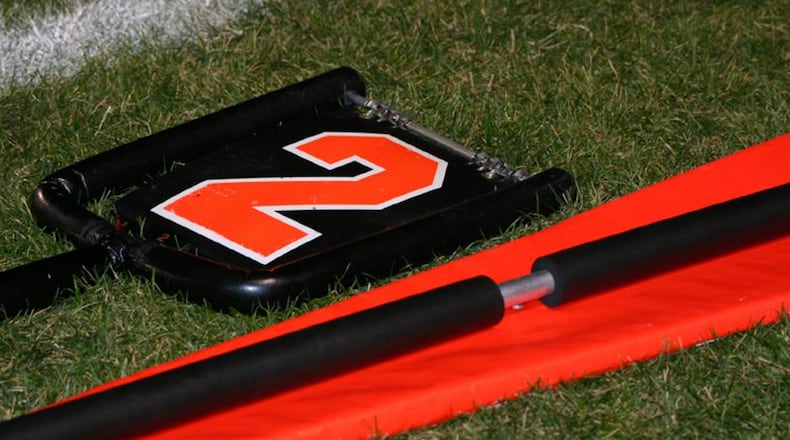GHSF Daily is expanding its Four Questions feature this season beyond head coaches to other voices in high school football. Today's interviewee is Jeff Hopp, head athletic trainer for the Marietta Blue Devils.
Jeff Hopp, Marietta head athletic trainer
1. What does your staff at Marietta High School look like, and what all do you do? "We have three full-time athletic trainers, three student athletic trainers from the Life University Masters in Athletic Training program, 35 high school student athletic training aides and eight team physicians. As the head athletic trainer, I am responsible for all aspects of the sports medicine program, from administrative to medical coverage. Our two other athletic trainers, Olivia King and Erika Davis, teach healthcare occupations classes through the CTAE program along with their athletic training duties providing medical care. We serve as clinical instructors for Life University, so those students are here working with us on a daily basis getting hands-on experience to prepare them to sit for the NATA BOC certification exam and become athletic trainers. We work closely with our team physicians, which include an orthopedist, general medicine, neurosurgeon, neurologist, cardiologist, dermatologist, dentist and plastic surgeon, so we are able to refer and expedite care for our athletes for almost any injury. A typical day in our athletic training room starts immediately after school with athletes coming in for minor rehab, treatments and taping before practice. Once we get most of those athletes to practice, our focus turns to kids who have more extensive rehab due to serious injuries or surgeries. Once all rehab is done, we move to practice and game coverage, and our day does not end until all athletic events are over."
2. What are the requirements for the student athletic training aides, and what do they get out of being in the program? "Our students are required to maintain a 2.5 GPA at all times, work with us for at least two out of three seasons, attend one practice per week and assist with assigned games. Although some of our students are just looking for a way to be involved in an extracurricular activity, most of our students are interested in a career in healthcare, so they are gaining hands-on experience. They learn skills like taping, stretching and basic first aid and are CPR/AED certified. They work with us at practices and games helping us set up, care for the athletes and clean up afterwards. We established a scholarship about five years ago for graduating seniors who intend to pursue a healthcare career. We have a wall of honor in our athletic training clinic with the names of all the students who have graduated from our program and those who go on to work in healthcare. We also like to add their medical credentials behind their name. Thanksgiving dinner at our house the day before Thanksgiving has become a growing tradition over the years for current and former students. It is now an all-day event where we will have 30-40 people at the house. We are able to show our kids our appreciation for their hard work and catch up with former students and hear about their accomplishments. Working with these students is one of the best parts of the job, and that has become my favorite day of the year."
3. Why is it important for a high school to have an athletic trainer as part of the staff? "Athletic trainers play a vital role in any athletic program, as we are the primary medical providers for the athletes. Coaches are obviously concerned about the health of their athletes, but they are not healthcare providers, and their primary responsibility is coaching. Athletic trainers are state-licensed and nationally board certified healthcare providers, and our primary job is the health and well-being of our athletes. Of course we like to see our teams win, but the safety of our athletes comes first. Athletic trainers evaluate and make return-to-play decision on everything from concussions to ankle injuries. We are usually the first ones to evaluate their injuries and then work with them through their rehab to get them back to playing. Having an athletic trainer on the sideline that can recognize subtle signs and symptoms and differentiate between a mild injury versus something that could be potentially life-threatening is invaluable."
4. How has athletic training at the high school level changed over the years? "In the 23 years I have been working in high school athletics, a lot has changed with athletic training at the high school level. When I started, mostly just the larger schools had athletic trainers, and they were typically provided by outside companies such as physical therapy clinics, hospitals or physician's offices, and we were primarily there after school for practice and games. In the late '90s, maybe 25 to 30 percent of high schools in the state had access to an athletic trainer. Now, 85 percent of high schools have access to athletic training coverage, and 39 percent of those have full-time coverage by athletic trainers. In addition to that, more and more athletic trainers are being hired by the high school directly, allowing us to provide complete care for athletes just like at the collegiate level. At Marietta, we are constantly striving to provide the best care possible for our athletes. We were the first high school in the state to have an EKG machine and the first high school in the country to have the new GameReady Med4 Elite. Things have improved tremendously, but we are still striving for every high school to have access to a full-time athletic trainer so that proper medical care can be provided."
Produced by Georgia High School Football Daily, a free e-mail newsletter. To join the mailing list, click here.
About the Author
The Latest
Featured

